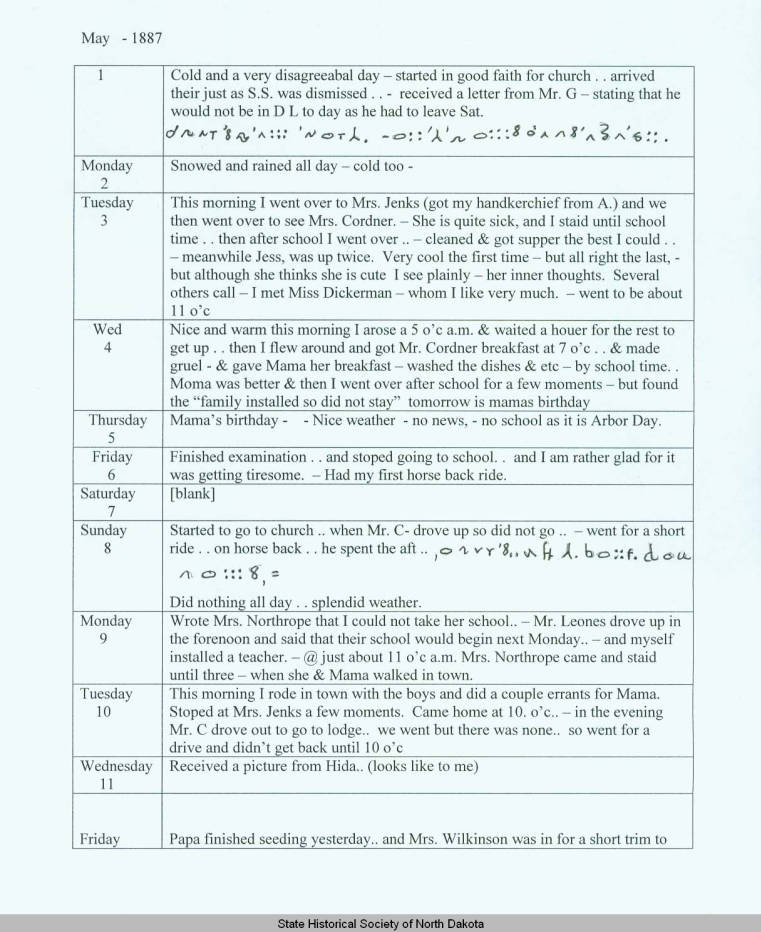The first supporting question, “who was Mae Roberts?” helps students use sources to unwrap the context of the time and topic being examined. Mary Bethia Roberts’ name, Mary, was shortened to May by neighbors, and then changed to Mae at her christening. During her teen years she was called Mae by her family and friends. Mae was born July 16, 1869 in Minnesota. She moved to a homestead farm one mile from Devils Lake with her family on May 17, 1884, the day of the first entry in her diary. Her father, Albert, was already on the claim, but the train brought Mae with her mother, Isabella McKinley Roberts, baby sister, and younger brother Roy. Her Persian cat traveled with them in a basket. The Roberts farm was one mile from Devils Lake which gave Mae and her family the opportunity to participate in many urban events such as Odd Fellows Lodge meetings, dances, and other social and political events. Mae, however, was happy to work in the fields with her father and brothers and ride the prairies on horseback enjoying the wildflowers and birds. In the summer of 1885, she took the teachers’ examination to take a job at a school twenty miles south of her family’s home for three months. She was not quite sixteen. She returned to Devils Lake after her school closed and resumed her own schooling.
On April 5, 1887, she began to write the series of examinations which would give her the Teacher’s certificate, third class. This certificate allowed her to teach grade school at Sweetwater (four miles from home) for 12 months. Of the twelve who took the exam with her, she was the only one who passed. In the back of her diary, Mae kept a record of her expenditures. During the two months included here, she purchased silk embroidery floss (10c), 2 yards of Spanish lace (22c), a pair of “fine shoes” ($4.00), 2 yards of blue ribbon (30c), a knit undershirt (90c), 5 skeins of yarn (75c), and 5 yards of white ribbon (60c). In October 1888, Mae traveled to Grand Forks to study at the University of North Dakota. She enjoyed her studies, but she got into trouble at the university when she and friends took a buggy ride to East Grand Forks. The Minnesota city was off-limits to UND students because of its bars and bad reputation. She was disciplined by the UND president for breaking the rules. There are few entries in the diary after January 1889.
Mae Roberts’ diary is a small, dark red patterned book with a brass clasp. Occasionally she wrote a line or two in a kind of code. She apparently feared that someone might read her diary. When she donated the diary to the State Historical Society of North Dakota she did not mention the code or offer a means for translating it. Source: SHSND MSS 20068 Mae Roberts Jensen Diary
Facilitate a class discussion on the time period and context of the world she lived in. Students will need to use library and internet sources to build an understanding of what was going on during that time period. What activities did teenagers participate in? What kind of jobs did they get? How much did they get paid? How did they socialize with their friends? What was school like? What were the clothing styles like? Did they play sports, read books, or listen to music? What were the major news stories of the day? How did their gender, time period, and location influence or reflect their interests? Complete the following task using the sources provided to build a context of the time period and topic being examined.
Formative Performance Task 1
Read the featured source and do independent research to create a context of the world Mae Roberts lived in. Write a summary or create a graphic organizer that provides some context for what the world was like when Mae Roberts was a teenager.
Featured Sources 1
The source featured below is a primary source. Primary sources are the raw materials of history—original documents, personal records, photographs, maps, and other materials. Primary sources are the first evidence of what happened, what was thought, and what was said by people living through a moment in time. These sources are the evidence by which historians and other researchers build and defend their historical arguments, or thesis statements. When using primary sources in your lessons, invite students to use all their senses to observe, describe, and analyze the materials. What can they see, hear, feel, smell, and even taste? Draw on students’ knowledge to classify the sources into groups, to make connections between what they observe and what they already know, and to help them make logical claims about the materials that can be supported by evidence. Further research of materials and sources can either prove or disprove the students’ argument.
| Source A |
Mae Robert’s Diary (1884-1889) 
http://www.digitalhorizonsonline.org/digital/collection/uw-ndshs/id/3759 |


